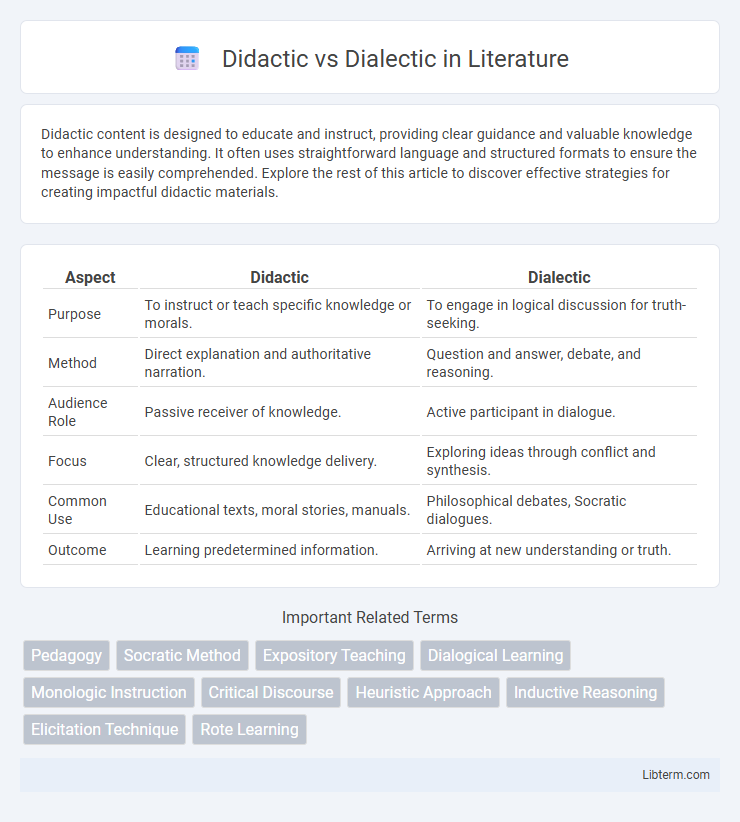Didactic content is designed to educate and instruct, providing clear guidance and valuable knowledge to enhance understanding. It often uses straightforward language and structured formats to ensure the message is easily comprehended. Explore the rest of this article to discover effective strategies for creating impactful didactic materials.
Table of Comparison
| Aspect | Didactic | Dialectic |
|---|---|---|
| Purpose | To instruct or teach specific knowledge or morals. | To engage in logical discussion for truth-seeking. |
| Method | Direct explanation and authoritative narration. | Question and answer, debate, and reasoning. |
| Audience Role | Passive receiver of knowledge. | Active participant in dialogue. |
| Focus | Clear, structured knowledge delivery. | Exploring ideas through conflict and synthesis. |
| Common Use | Educational texts, moral stories, manuals. | Philosophical debates, Socratic dialogues. |
| Outcome | Learning predetermined information. | Arriving at new understanding or truth. |
Introduction to Didactic and Dialectic
Didactic methods emphasize structured teaching aimed at imparting specific knowledge or skills through clear, direct instruction, often involving lectures or demonstrations. Dialectic, rooted in Socratic dialogue, focuses on critical thinking and reasoning by engaging in question-and-answer exchanges to uncover underlying truths or resolve contradictions. Both approaches serve distinct educational purposes: didactic prioritizes knowledge transmission, while dialectic fosters analytical discussion and intellectual development.
Defining Didactic Methods
Didactic methods emphasize structured instruction where a teacher imparts knowledge directly to learners through clear explanations, demonstrations, and organized content delivery. These techniques prioritize clarity, repetition, and systematic progression of concepts to ensure comprehension and retention. Common didactic approaches include lectures, textbooks, and instructional videos designed to convey factual information efficiently.
Understanding Dialectic Approaches
Dialectic approaches emphasize dialogue and critical questioning to uncover underlying assumptions and synthesize diverse viewpoints, fostering deeper understanding and knowledge construction. Unlike didactic methods, which deliver information unilaterally, dialectic techniques engage participants in collaborative reasoning and reflective thinking. This interactive process enhances cognitive skills by encouraging openness to complexity and multiple perspectives.
Historical Origins of Didactic and Dialectic
Didactic methods originated in ancient Greek education, emphasizing direct instruction and moral teaching through storytelling and aphorisms, notably in works by Hesiod and Aesop. Dialectic traces back to Socratic dialogues, where dialectical reasoning was used for critical examination and truth-seeking through question-and-answer discourse. The historical roots of didactic practices lie in imparting knowledge, while dialectic evolved as a philosophical technique fostering analytical thinking and debate.
Key Differences Between Didactic and Dialectic
Didactic refers to a teaching approach centered on delivering information and instructing learners with clear, structured content, often emphasizing one-way communication. Dialectic involves a method of dialogue and reasoning where ideas are examined through questioning, debate, and synthesis to reach deeper understanding or truth. The key difference lies in didactic's focus on transmission of knowledge versus dialectic's emphasis on interactive exploration and critical thinking.
Applications in Modern Education
Didactic teaching emphasizes structured knowledge transmission and clear learning objectives, commonly applied in traditional classrooms and standardized testing environments. Dialectic methods foster critical thinking and dialogue, widely used in seminars, debate clubs, and collaborative projects to encourage active student engagement and deeper understanding. Modern education integrates both approaches to balance content delivery with interactive learning, enhancing cognitive skills and adaptability across diverse educational settings.
Advantages of Didactic Teaching
Didactic teaching offers clear advantages by providing structured and concise delivery of information, which enhances knowledge retention and comprehension in learners. It allows educators to efficiently cover large amounts of content within limited time frames, ensuring consistent learning outcomes across diverse groups. Emphasizing direct instruction, didactic methods facilitate measurable assessment and quick identification of learning gaps.
Benefits of the Dialectic Process
The dialectic process enhances critical thinking and deepens understanding by encouraging dialogue that challenges assumptions and explores multiple perspectives. This method fosters intellectual flexibility and collaborative problem-solving, leading to more nuanced conclusions. Engaging in dialectic helps individuals develop reasoning skills and refine ideas through continuous questioning and reflection.
Choosing the Right Method for Learning Goals
Choosing the right method between didactic and dialectic hinges on learning objectives: didactic suits structured knowledge delivery and foundational skills, while dialectic fosters critical thinking and interactive understanding through dialogue. Didactic teaching efficiently imparts information to large groups, ideal for memorization and standardized learning outcomes, whereas dialectic methods excel in developing analytical skills through question-and-answer exchanges. Aligning method selection with specific goals ensures effective knowledge acquisition and deeper cognitive engagement.
Conclusion: Integrating Didactic and Dialectic Strategies
Integrating didactic and dialectic strategies enhances educational outcomes by combining direct instruction with critical dialogue, fostering both knowledge acquisition and analytical thinking. Didactic methods deliver clear, structured content, while dialectic approaches encourage active engagement and deeper understanding through questioning and discussion. This synergy creates a dynamic learning environment that supports comprehensive cognitive development and practical application.
Didactic Infographic

 libterm.com
libterm.com